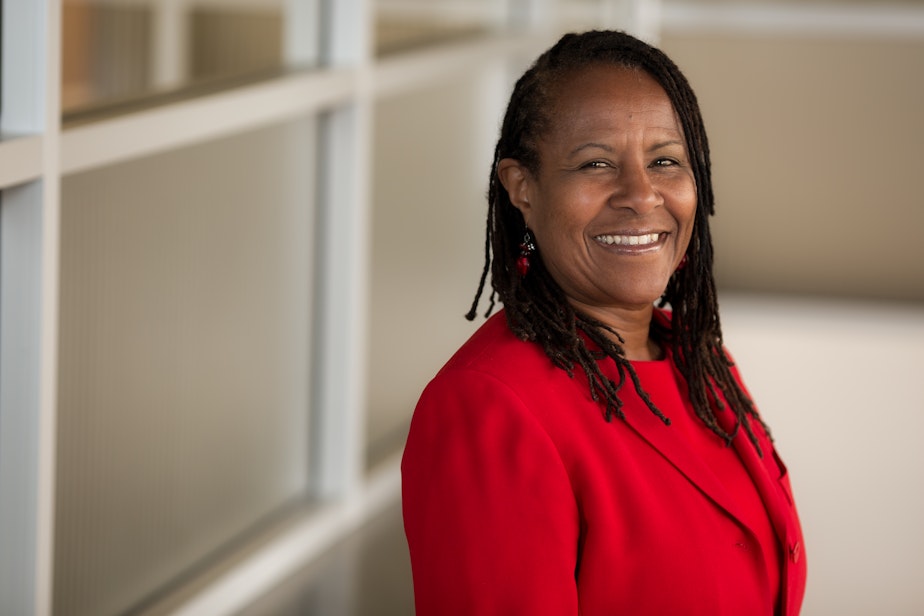Racism and #journalismsowhite: A personal story from KUOW's general manager

Journalism is so white.
That’s a criticism of newsrooms in America, and the numbers show that it’s true: In radio, just 9.4 percent of journalists are people of color.
Caryn Mathes, president and general manager of KUOW, has experienced this since the early days of her career, when she was a radio reporter in Ohio.
She recalled her first assignment — a robbery at a used-car dealership.
Sponsored
“There’s this person who had been held at gunpoint,” Mathes recalled. “Apparently the perpetrator had been a black male."
A witness, a white woman, was "throwing the n-word all around," Mathes said.
"She looked at me, and she goes, ‘I didn't know they had colored reporters.’"
Mathes shrugged. She didn’t say anything. But it stayed with her.
“You just push on,” she said. “When I was in television news, it was a struggle because everybody had an opinion on what you ought to be as a black reporter.”
Sponsored
One year, she heard from black people saying she didn’t interview enough of them.
“I'd be motioning people over, and people were shy like, no, no, no, I don't want to be on camera,” she said. “The next year I was on a mission. I was going to get black people on camera. And then you hear from white people saying, Why does she only interview black people?
Mathes has lived in Seattle since 2013, when she became KUOW’s general manager. Seattle, she quickly realized, was so white. She said her first Christmas, she spent six hours looking for a black Santa doll. She found him — in a bargain bin at a J.C. Penney.
“I scooped him up, and I was so excited, and I went to the cashier, and I said, ‘Do you have any other items like this? Do you have any brown skin angels?’”
Without missing a beat, the salesperson replied, "Oh, we don't do that politically correct stuff."
Sponsored
“I was dumbfounded,” Mathes said. “I thought, okay, items the color of 90 percent of the population of the earth are too politically correct.”
For Mathes, the importance of a brown-skinned Santa carries over to the news business.
“You want to see and hear yourself,” she said. “If people don't see and hear themselves, their perspectives, their stories, their challenges, how they're personally living the news — if you never see that reflected, you're going to dismiss that medium as irrelevant.”
Mathes recalled a pivotal moment as a child, seeing the black experience televised.
She had come home from school to see her mother and grandmother crying in front of the TV.
Sponsored
“They were watching film of people being mistreated at the Selma march. Firehoses being turned on these young kids marching for equal rights,” Mathes said. “I said, ‘Mom, do we know those people. And my mom said, ‘Yeah, we know them. They're us.’
“What would have happened if that film had never come to light?” Mathes said. “How much longer would it have taken the struggle to get to a point where some things changed? If no one was watching and no one was listening?
“I worry about that today because for all the stories that have come forward, from amateur videos and cell phone videos, there's still a million things a day that happen around the world when no one is watching and no one is offering a voice or perspective.”
Watching the TV that day wasn’t the first time Mathes saw people treated unfairly for being black. She recalled a time at the grocery store. She was about 7, her forehead to the handlebar of the shopping cart, and her mother was very pregnant.
The cart was piled high, and her mother didn’t feel she could push it to the car. So Mathes stayed with the cart while her mother got the car.
Sponsored
“I'm holding the basket and I feel this bump, and I look and somebody has bumped me with a shopping cart,” she said. “I try to scooch out of the way, and this guy hits me again. It was this older man, I think a farmer because he was dressed in his work grays. He just had this horrible sneer on his face looking at me and he kept hitting me with that shopping cart until he knocked me right off my feet.
“I was a little kid thinking, ‘What did I do wrong?’ It was probably just him thinking, Gosh, what's this little colored kid doing entering the front door of the store? Because there were still stores at that time when black people couldn’t go in the front door.
“Black women couldn't try on clothing. That's why I'm a catalog shopper to this day, because I watched my mom and my grandmother order clothes from catalogs because you couldn't go into a major department store as a black woman and try on clothing.”
Mathes never told her mother about the incident.
“I didn't want her to feel bad,” she said. “But it taught me that, Wow, there are people there that are just going to react to your outer covering and you're going to have to deal with that.”
Jamala Henderson can be reached at jhenderson@kuow.org. Have a story idea? Use our story pitch form.



